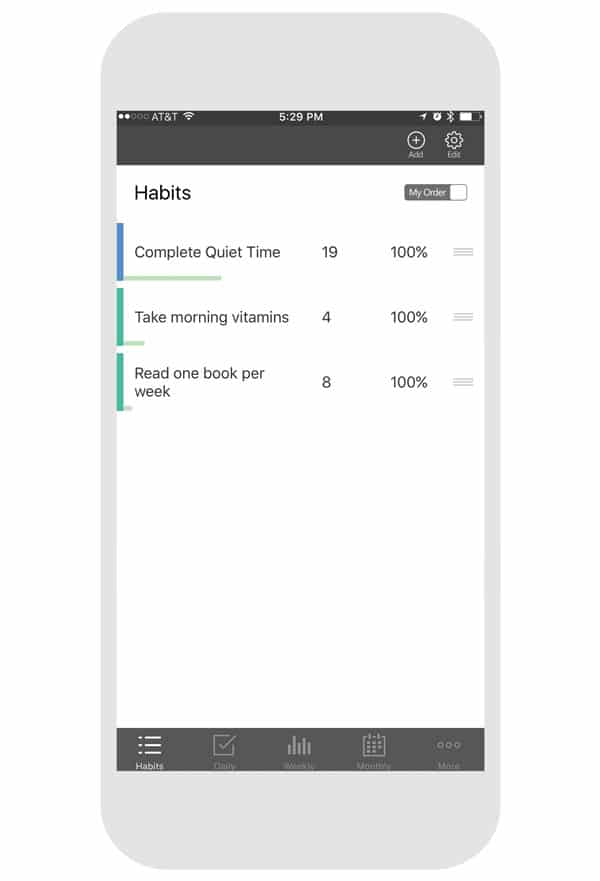Plus My Favorite Habit-Tracking App
Great results don’t just happen. You don’t usually drift to a destination you would have chosen. Instead, you have to be intentional, force yourself to get clear on what you want and why it’s important, and then pursue a plan of action that accomplishes your objective.
Sometimes, this involves setting an achievement goal with a definable end point, such as finishing a book, running a marathon, or hitting a financial benchmark. But often, significant achievements are the result of ingrained habits over time.
For example:
Bill and Nancy have an awesome marriage. It’s not just that they were lucky and married the right person. It’s that they have intentionally cultivated intimacy. As simple as it sounds, they have gone on a date night every week for more than two decades. This habit has provided a context in which they can have deep, meaningful conversations about the things that matter most.
Spencer is in the best shape of his life. Whenever he goes in for his annual physical, his doctor is amazed. He has continued to improve for each of the last five years. The surprising thing is that Spencer just turned sixty last year. But his health is not an accident. It all began when he began to cultivate the habit of working out five days a week.
Or take Larissa. She has built a seven-figure business in just three years. You might be tempted to write off her success to the fact that she stumbled onto a great idea at exactly the right time. Certainly, that played a role. But if you asked her the secret to her success, she would chalk it up to her habit of making five sales calls every single week.
In all these cases, habits are the driving force.
If you have been through my course, 5 Days to Your Best Year Ever, you know that to realize your dreams, you must reduce them to written goals that meet the SMARTER standard. By that I mean they are specific, measurable, actionable, risky, time-keyed, exciting, and relevant.
Usually, these are achievement goals like the book and marathon examples above. But we can also employ habits in making our dreams real, just like Spencer and Larissa. The trick is to know when and how to use them.
When to Use a Habit
Habits are an effective way to achieve your dreams, but only if you know when and how to use them. There are two times when you can use a habit in goal-setting.
- When you have a vague aspiration that you just can’t seem to make measurable. I call this a habit goal. For example, let’s say:
- You want to grow closer to God. You could set a habit goal like this: “Spend 20 minutes a day in Bible reading and prayer, five days a week at 6:00 a.m., beginning January 1st, and do it for 70 days in a row.”
- You want to develop more intimacy with your spouse. You could set a habit goal like this: “Take my spouse out for dinner and an evening of conversation, once per week, on Friday nights at 6:00 p.m., beginning March 1st, and do it for 52 weeks straight.
-
When you want to use a habit as a step—perhaps the only step—in completing an achievement goal. I call this a habit step. For example, let’s say:
- You want to write a 50,000-word book by June 30. You could identify several next steps, or you could focus on simply installing a habit. For example, “Write 500 words a day, five days a week at 6:00 a.m., beginning on February 1, and do it for 100 days straight.”
-
You want to lose 30 pounds by September 30. You could identify several next steps, or (again) you could focus on simply installing a habit. For example: “Walk 30 minutes per day, five days a week at 6:00 a.m., beginning on January 1st, and do it for 66 days straight.” Or: “Log what I am eating in MyFitnessPal, every day, immediately after each meal or at the end of the day, beginning January 1, and do it for 70 days straight.”
How to Use a Habit
State the habit—whether it’s a habit goal or a habit step—using the SMARTER framework. This is very similar to how you would state an achievement goal with a few important changes. Take a closer look at the last example:
Log what I am eating in MyFitnessPal, every day, immediately after each meal or at the end of the day, beginning January 1, and do it for 70 days straight.
It’s specific, measurable, and actionable. It’s also risky. Not the goal itself. Usually, it is something that, on its own, is pretty easy. The risk is in being consistent over the prescribed period of time.
It’s also time-keyed. But unlike an achievement goal where you merely have a deadline—for instance, finish my book by March 1—your habit goals and steps need four time-keys:
- Start date. This is when you intend to begin installing this habit.
- Habit frequency. This is how often you will observe this habit. It could be daily, specific days of the week, weekly, monthly, and so on.
- Time trigger. This is when you want to do the habit. It could be a specific time each day, week, and so on. This makes it easier to become consistent if you can do the habit at the same time.
- Streak target. This is how many times in a row you must do the habit before you can consider it installed and check it off your list. (Keep in mind that, on average, it takes 66 days to install a habit. I typically round this up to at least 70 for good measure.)
How to Track a Habit
It’s one thing to write down a streak target. It’s another to keep track of it. Like all tools or systems, use the one that works for you. This could be a check-mark on your calendar. Jerry Seinfeld famously used this system to build his writing habit. You can also track it in your journal or set it as recurring task in your task-management system.
Currently, I am using—and loving!—Habit Bull. It is available for both iOS and Android devices. It is based on the Seinfeld’s method. Specifically, it allows you to:
- Establish good habits or break bad habits. You can track both.
- Create any frequency you want—specific days of the week, and so on.
- Identify your streak target—that is, how many times in a row must you complete the habit before you consider it installed.
- Set reminders. These are highly flexible. For example, if you want to work out at a specific time on weekdays and a different time on Saturdays, you can set different reminders for the same habit.
- Track progress. Habit Bull tracks your results and displays them in reports and graphs.

There are a million ways to achieve our dreams. Developing habits that serve our goals is one you can add to your portfolio and put to work today.
Disclosure of Material Connection: Some of the links in the post above are “affiliate links.” This means if you click on the link and purchase the item, we will receive an affiliate commission. Regardless, we only recommend products or services we use and believe will add value to our readers. We are disclosing this in accordance with the Federal Trade Commission’s 16 CFR, Part 255: “Guides Concerning the Use of Endorsements and Testimonials in Advertising.









